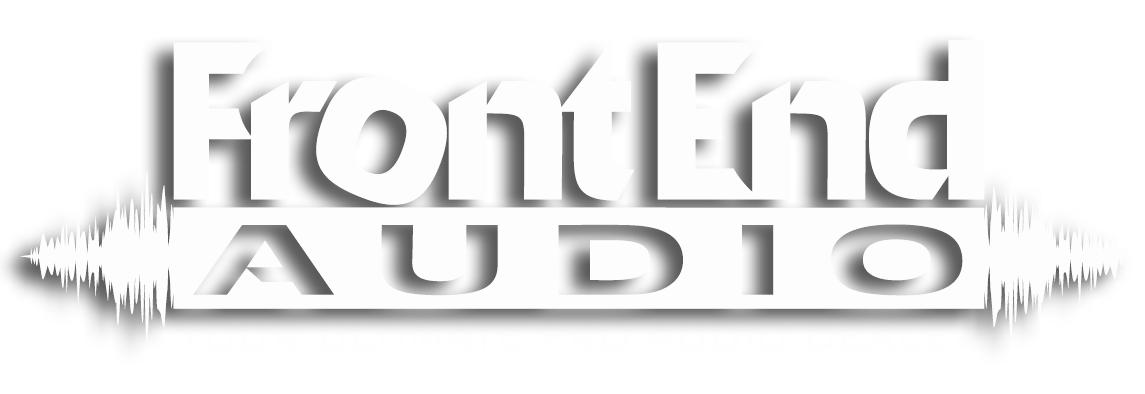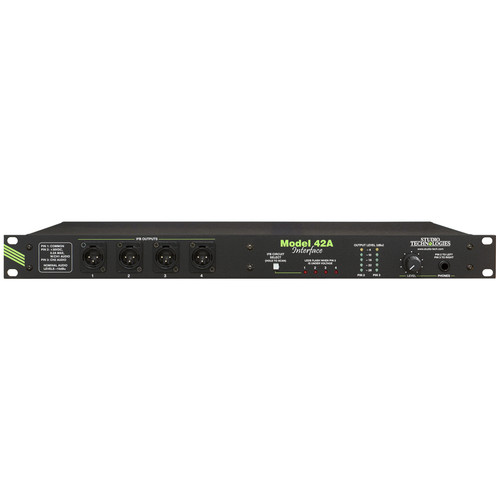The Studio Technologies Model 47 Interface is a dual 2-wire analog audio to 4-wire analog audio interface designed to interface 2-wire full-duplex party-line intercom circuits with 4-wire audio circuits associated with matrix intercom systems. Other specialized audio system interfacing applications can also be supported.
The Studio Technologies Model 47 Interface provides two independent full-featured 2-channel interfaces. Each interface contains two hybrid circuits which include automatic nulling capability. The analog circuitry, under software control, provides excellent audio quality and high return-loss. The interfaces are compatible with powered and unpowered 2-wire party-line circuits. They are capable of supplying DC power to devices such as user belt packs and user stations. Independent power sources are provided for both channels (pins 2 and 3) of each interface, allowing direct support for broadcast source assignment panel (SAP) applications. Configuration settings allow the 2-wire and 4-wire interface circuitry to be compatible with a range of nominal signal levels. Audio level meters provide user confirmation of system performance during setup and operation. Applications for the Studio Technologies Model 47 include mobile and fixed television facilities, theme park and theater installations, and industrial testing environments. Standard audio connectors are used for all input and output signals. The Studio Technologies Model 47 mounts in one space (1U) of a standard 19-inch rack enclosure and requires 100-240 volts, 50/60 Hz for operation.
2-Wire Interfaces
The Studio Technologies Model 47’s 2-wire interfaces are optimized for direct connection with dual-channel party-line (PL) intercom circuits. In addition, single-channel party-line intercom circuits can also be connected. Many broadcast applications use the dual-channel TW-series from RTS, including their popular BP325 belt pack. Other industry-standard single- and dual-channel PL intercom systems, including those from Clear-Com®, are also directly compatible. To provide optimal signal matching and interface performance the nominal level of the Studio Technologies Model 47’s 2-wire interfaces can be selected. Using DIP switches, accessible on the front panel, the nominal levels can be selected to be either –10 or –14 dBu, settings that should allow compatibility with virtually all party-line systems. The Studio Technologies Model 47’s 2-wire interfaces can correctly function with powered (“wet”) or unpowered (“dry”) intercom circuits. Powered circuits have a DC voltage present, typically provided by power supplies such as the RTS PS20. This DC power, normally 30-32 volts, provides energy for connected devices such as user stations or belt packs. In this type of application the Studio Technologies Model 47 is configured to operate in its external 2-wire power source mode. In this mode the Studio Technologies Model 47’s circuitry maintains the required high-impedance load and, as in all cases, draws no power from the party-line circuit. An auto-terminate function ensures that should a “wet” circuit not be connected, the Studio Technologies Model 47’s interface circuitry will remain stable. This unique feature makes certain that objectionable audio signals, including oscillations and “squeals,” will infrequently be sent to the connected 4-wire device.
Analog Hybrids with Auto Nulling
A key reason that the Studio Technologies Model 47’s interfaces achieve excellent audio performance is the design of the 2-wire-to-4-wire hybrid circuits. They provide low noise and distortion, good frequency response, and high return-loss (“nulling”), even when presented with a wide range of 2-wire conditions. Unlike telephone-line (“POTS”) oriented DSP-based hybrid circuits, the Model 47’s analog circuitry provides extended frequency response. With a pass band of 100 Hz on the low-end and 8 kHz on the high-end, natural-sounding voice signals can be sent to, and received from, the 2-wire party-line circuits.
4-Wire Interfaces
Associated with the 4-wire portion of the Studio Technologies Model 47’s interfaces are analog line-level inputs and outputs. These are intended to interconnect with a variety of 4-wire devices, including matrix intercom systems, audio-over-fiber transmission systems, and other specialized audio equipment. The input and output circuitry is transformer-coupled to minimize the chance of hum, noise, or ground “loop” issues. A key characteristic of the Studio Technologies Model 47’s design is the ability to select the 4-wire input and output nominal levels. This helps to ensure compatibility with virtually all audio equipment. Front-panel-accessible DIP switches allow the nominal levels to be configured from among four choices: 0, +4, +6, or +8 dBu. The 0 dBu setting was specifically provided for compatibility with Clear-Com matrix intercom systems. The +4 dBu setting allows “standard” audio signals to be directly connected. Digital matrix intercom systems from Riedel® can be effectively connected using the +6 dBu setting. And the +8 dBu setting allows proper level matching with the popular ADAM® series of matrix intercom systems from RTS. This setting also applies to the related RVON-I/O VoIP product.
Pro Audio Quality
The Studio Technologies Model 47’s audio circuitry was designed in the spirit of professional audio equipment, rather than that found in typical party-line intercom gear. High-performance components are used throughout, providing low-distortion, low-noise, and high headroom. Using passive and active filters, the frequency response is limited to approximately 100 Hz to 8 kHz. This range was selected to provide excellent performance for human speech, while maximizing the ability of the hybrids to create substantial “nulls.” When the Studio Technologies Model 47’s internal DC power sources are selected to provide 2-wire party-line intercom power, enhanced audio performance can also be expected. The quality of the DC power sources is excellent, with very little noise, hum, or “hiss” being added to the 2-wire connections.
Special Applications
While the Studio Technologies Model 47 is designed to directly integrate into typical applications, it’s ready to support the “one-in-a-million” situations too. To accomplish this DIP switches, accessible on the back panel, allow some of the automatic features to be disabled. For example, one DIP switch allows the autoterminate feature to be disabled. While this feature can help maintain audio quality, advanced users might need to disable it. This would allow full control over the Studio Technologies Model 47’s four hybrid circuits, enabling them to be used completely independently. A second DIP switch changes the way in which the front-panel auto null pushbutton switches operate. Normally pressing one of the buttons begins the process of auto nulling both channels associated with an interface. The alternate switch mode allows each auto null sequence to be activated independently. One tap of the auto null button will begin the auto null process for interface one. Two taps of the button will begin the auto null process for channel two. For installer-selected applications, three opto-coupled inputs allow selected Studio Technologies Model 47 features to be remotely controlled. These features include remote auto nulling for each interface and remote “mic kill” activation.
Simple Installation
The Studio Technologies Model 47 uses standard 3-pin XLR connectors to allow convenient interconnection in most broadcast and general audio environments. For flexibility, access to the 2-wire party-line intercom interfaces can be made using the connectors provided on both the front and back panels. In permanent installations the back-panel connectors will typically be utilized. In other settings, such as field television production, front-panel access allows intercom belt packs to be rapidly connected, without requiring access to the inside of a rack enclosure or necessitating the use of a secondary input/output (I/O) panel. The Studio Technologies Model 47 is housed in a rugged steel enclosure that is designed to be “road tough.” It mounts in one space (1U) of a standard 19-inch rack enclosure. The mains input source can range from 100 to 240 volts, 50/60 Hz allowing direct operation virtually anywhere in the world. A switch-mode power supply, contained within the Studio Technologies Model 47’s enclosure, provides conversion of the mains input power into the DC voltage required by the party-line power supply circuits. Also contained within the unit is a DC-to-DC converter that creates the voltages required by the analog and digital circuitry. These efficient power supplies help to ensure cool, reliable operation in a variety of settings.
Design Philosophy
While the “bits and pieces” that make up the Studio Technologies Model 47 have been described in conventional terms, the real strength of the unit rests in how it integrates and performs in the “real world.” Before beginning the Studio Technologies Model 47’s design process, conversations with industry experts quickly made it apparent that installing and configuring existing 2-wire-to-4-wire interface units was invariably a time-consuming, aggravating process that required the talent of an expert to achieve reasonable results. And even under those constraints the resulting audio performance was often mediocre. Any new design had to look at the application in a different way. This led to the over-riding Model 47 design goal: create a “new breed of cat,” fundamentally changing how broadcast 2-wire-to-4-wire interface equipment fit into actual applications.
Studio Technologies Model 47 Interface Features
- Two 2-channel party-line intercom interfaces
- Four analog hybrids with auto null capability
- Input and output level metering
- Excellent audio quality
- Dual-channel intercom power sources
- Direct support for broadcast SAP panel applications
- Standard audio connectors
- Universal input mains powered
Studio Technologies Model 47 Interface Specifications
- General Audio:
- Frequency Response: ±2 dB 100 Hz to 8 kHz
- Distortion (THD+N): <0.5%, Measured at 1 kHz, 4-Wire Input to 2-Wire Interface Pin 2
- Signal-to-Noise Ratio: >55 dB, Measured at 1 kHz, 4-Wire Input to 2-Wire Interface Pin 2
- Connectors:
- Inputs from 4-Wire: 3-Pin Female XLR
- Outputs to 4-Wire: 3-Pin Male XLR
- 2-Wire Party-Line Intercom: 3-Pin Male XLR
- Remote Control: 10-Pin Header, Requires User-Provided 10-Pin Ribbon Connector Assembly
- AC Mains: 3-Blade, IEC 320 C14 (Mates with IEC 320 C13)
- 2-Wire Party-Line Intercom Interfaces: 2
- Type: 2-Channel Party-Line (PL), Unbalanced (Pin 1 Common; Pin 2 DC with Channel 1 Audio; Pin 3 Channel 2 Audio or DC with Channel 2 Audio)
- Compatibility: Single- and Dual-Channel Intercom Systems Such As From RTS® and Clear-Com®
- Impedance, External Power Mode: >10 k Ohms
- Impedance, Internal Power Mode: 200 Ohms
- Nominal Level: –10 or –14 dBu, Selectable
- “Mic Kill” Signal: Square Wave, 24 kHz, ±1%
- 2-Wire Party-Line Power Sources: 4, 2 Per Interface
- Rating: 30 Volts DC Nominal, 300 milliamperes Maximum, Software Monitored and Controlled
- Hybrids: 4, 2 Per Interface
- Topology: 3-Section Analog Circuitry Compensates for Resistive, Inductive, and Capacitive 2-Wire Party-Line Loads
- Nulling Method: Automatic Upon User Initiation, Processor Implements Digital Control of Analog Circuitry; Null Settings Stored in Non-Volatile Memory
- Nulling Line Impedance Range: 120-350 Ohms
- Nulling Cable Length Range: 0-3500 Feet, Typical
- Trans-Hybrid Loss: >40 dB, Typical at 800 Hz
- 4-Wire Inputs: 4, 2 Per Interface
- Type: Transformer-Coupled, Capacitor Isolated
- Impedance: 13 k Ohms
- Nominal Level: 0, +4, +6, or +8 dBu, Selectable in Tandem with Nominal Output Level
- Maximum Level: +22 dBu
- 4-Wire Outputs: 4, 2 Per Interface
- Type: Transformer-Coupled, Capacitor Isolated
- Impedance: 50 Ohms Nominal
- Nominal Level: 0, +4, +6, or +8 dBu, Selectable in Tandem with Nominal Input Level
- Maximum Level: +20 dBu into 2 k Ohms
- Meters: 8
- Function: Displays Level of 4-Wire Inputs and Outputs
- Type: 5-Segment LED, Modified VU Ballistics
- Remote Control Inputs: 3
- Type: Optically Coupled
- Input: 3-32 Volts DC; 2 milliamperes Minimum for Operation, 20 milliamperes Maximum
- Functions: Auto Null Interface 1, Auto Null Interface 2, and “Mic Kill”
- AC Mains Requirement: 100-240 Volts (–15/+10%), 50/60 Hz, 1.2 Amperes Maximum @ 100 Volts, 0.7 Amperes Maximum @ 240 Volts
- Dimensions (Overall):
- Width: 19.0 inches (48.3 cm)
- Height: 1.72 inches (4.4 cm)
- Depth: 10.3 inches (26.2 cm)
- Mounting: One Space (1U) in a Standard 19-inch Rack
- Weight: 8.6 Pounds (3.9 kg)
Studio Technologies Model 47 Interface Includes
- 1 x Studio Technologies Model 47 Interface
- 1 x Power Cord
- 1 x User Guide
- 3 Year Warranty
No review yet, Be first to Write a Review
Write a Review


















 Sign Up for exclusive sales and offers!
Sign Up for exclusive sales and offers!